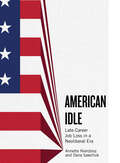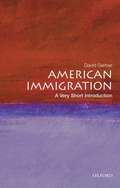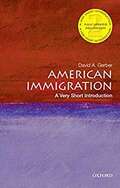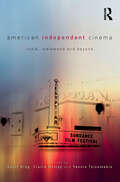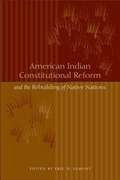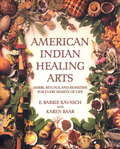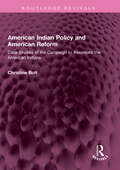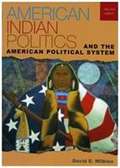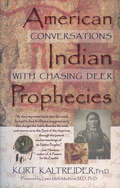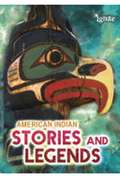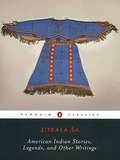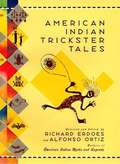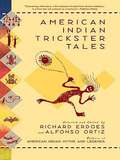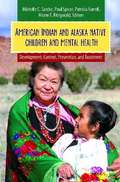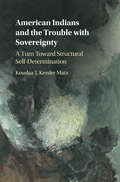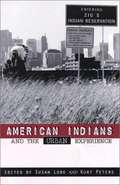- Table View
- List View
American Identity in the Age of Obama (Routledge Series on Identity Politics)
by Amílcar Antonio Barreto Richard L. O’BryantThe election of Barack Obama as the 44th president of the United States has opened a new chapter in the country’s long and often tortured history of inter-racial and inter-ethnic relations. Many relished in the inauguration of the country’s first African American president — an event foreseen by another White House aspirant, Senator Robert Kennedy, four decades earlier. What could have only been categorized as a dream in the wake of Brown vs. Board of Education was now a reality. Some dared to contemplate a post-racial America. Still, soon after Obama’s election a small but persistent faction questioned his eligibility to hold office; they insisted that Obama was foreign-born. Following the Civil Rights battles of the 20th century hate speech, at least in public, is no longer as free flowing as it had been. Perhaps xenophobia, in a land of immigrants, is the new rhetorical device to assail what which is non-white and hence un-American. Furthermore, recent debates about immigration and racial profiling in Arizona along with the battle over rewriting of history and civics textbooks in Texas suggest that a post-racial America is a long way off. What roles do race, ethnicity, ancestry, immigration status, locus of birth play in the public and private conversations that defy and reinforce existing conceptions of what it means to be American? This book exposes the changing and persistent notions of American identity in the age of Obama. Amílcar Antonio Barreto, Richard L. O’Bryant, and an outstanding line up of contributors examine Obama’s election and reelection as watershed phenomena that will be exploited by the president’s supporters and detractors to engage in different forms of narrating the American national saga. Despite the potential for major changes in rhetorical mythmaking, they question whether American society has changed substantively.
American Idle: Late-Career Job Loss in a Neoliberal Era (Inequality at Work: Perspectives on Race, Gender, Class, and Labor)
by Annette Nierobisz Dana Sawchuk Dana Sawchuck Annette Marie NierobiszIn American Idle, sociologists Annette Nierobisz and Dana Sawchuk report their findings from interviews with sixty-two mostly white-collar workers who experienced late-career job loss in the wake of the Great Recession. Without the benefits of planned retirement or time horizons favorable to recouping their losses, these employees experience an array of outcomes, from hard falls to soft landings. Notably, the authors find that when reflecting on the effects of job loss, fruitless job searches, and the overall experience of unemployment, participants regularly called on the frameworks instilled by neoliberalism. Invoking neoliberal rhetoric, these older Americans deferred to businesses’ need to prioritize bottom lines, accepted the shift toward precarious employment, or highlighted the importance of taking initiative and maintaining a positive mindset in the face of structural obstacles. Even so, participants also recognized the incompatibility between neoliberalism’s “one-size-fits-all” solutions and their own situations; this disconnect led them to consider their experiences through competing frameworks and to voice resistance to aspects of neoliberal capitalism. Employing a life course sociology perspective to explore older workers’ precarity in an age of rising economic insecurity, Nierobisz and Sawchuk shed light on a new wrinkle in American aging.
American Immigration After 1996: The Shifting Ground of Political Inclusion
by Kathleen R. ArnoldFew topics generate as much heated public debate in the United States today as immigration across our southern border. Two positions have been staked out, one favoring the expansion of guest-worker programs and focusing on the economic benefits of immigration, and the other proposing greater physical and other barriers to entry and focusing more on the perceived threat to national security from immigration. Both sides of this debate, however, rely in their arguments on preconceived notions and unexamined assumptions about assimilation, national identity, economic participation, legality, political loyalty, and gender roles. In American Immigration After 1996, Kathleen Arnold aims to reveal more of the underlying complexities of immigration and, in particular, to cast light on the relationship between globalization of the economy and issues of political sovereignty, especially what she calls “prerogative power” as it is exercised by the U.S. government.
American Immigration After 1996: The Shifting Ground of Political Inclusion (G - Reference, Information and Interdisciplinary Subjects)
by Kathleen R. ArnoldFew topics generate as much heated public debate in the United States today as immigration across our southern border. Two positions have been staked out, one favoring the expansion of guest-worker programs and focusing on the economic benefits of immigration, and the other proposing greater physical and other barriers to entry and focusing more on the perceived threat to national security from immigration. Both sides of this debate, however, rely in their arguments on preconceived notions and unexamined assumptions about assimilation, national identity, economic participation, legality, political loyalty, and gender roles. In American Immigration After 1996, Kathleen Arnold aims to reveal more of the underlying complexities of immigration and, in particular, to cast light on the relationship between globalization of the economy and issues of political sovereignty, especially what she calls “prerogative power” as it is exercised by the U.S. government.
American Immigration: A Very Short Introduction
by David GerberAmericans have come from every corner of the globe, and they have been brought together by a variety of historical processes--conquest, colonialism, the slave trade, territorial acquisition, and voluntary immigration. A thoughtful look at immigration, anti-immigration sentiments, and the motivations and experiences of the migrants themselves, this book offers a compact but wide-ranging look at one of America's persistent hot-button issues. Historian David Gerber begins by examining the many legal efforts to curb immigration and to define who is and is not an American, ranging from the Naturalization Law of 1795 (which applied only to "free-born white persons") to the Chinese Exclusion Act of 1882, the Emergency Quota Act of 1921, and the reform-minded Immigration and Nationality Act of 1965, which opened the door to millions of newcomers, the vast majority from Asia and Latin America. The book also looks at immigration from the perspective of the migrant--farmers and industrial workers, mechanics and domestics, highly trained professionals and small-business owners--who willingly pulled up stakes for the promise of a better life. Throughout, the book sheds light on the relationships between race and ethnicity in the life of these groups and in the formation of American society, and it stresses the marked continuities across waves of immigration and across different racial and ethnic groups. A fascinating and even-handed historical account, this book puts into perspective the longer history of calls for stronger immigration laws and the on-going debates over the place of immigrants in American society. About the Series: Combining authority with wit, accessibility, and style, Very Short Introductions offer an introduction to some of life's most interesting topics. Written by experts for the newcomer, they demonstrate the finest contemporary thinking about the central problems and issues in hundreds of key topics, from philosophy to Freud, quantum theory to Islam.
American Immigration: A Very Short Introduction (Very Short Introductions)
by David A. GerberAmericans have come from every corner of the globe, and they have been brought together by a variety of historical processes--conquest, colonialism, the slave trade, territorial acquisition, and voluntary immigration. In this Very Short Introduction, historian David A. Gerber captures the histories of dozens of American ethnic groups over more than two centuries and reveals how American life has been formed in significant ways by immigration. He discusses the relationships between race and ethnicity in the life of these groups and in the formation of American society, as well as explaining how immigration policy and legislation have helped to form those relationships. Moreover, by highlighting the parallels that contemporary patterns of immigration and resettlement share with those of the past - which Americans now generally regard as having had positive outcomes - the book offers an optimistic portrait of current immigration that is at odds with much present-day opinion. Newly updated, this book speaks directly to the ongoing fears of immigration that have fueled the debate about both illegal immigration and the need for stronger immigration laws and a border wall.
American Independent Cinema: indie, indiewood and beyond
by Yannis Tzioumakis Claire Molloy Geoff KingThe American independent sector has attracted much attention in recent years, an upsurge of academic work on the subject being accompanied by wider public debate. But many questions remain about how exactly independence should be defined and how its relationship might be understood with other parts of the cinematic landscape, most notably the Hollywood studios. Edited and written by leading authors in the field, American Independent Cinema: indie, indiewood and beyond offers an examination of the field through four sections that range in focus from broad definitions to close focus on particular manifestations of independence. A wide variety of examples are included but within a framework that offers insights into how these are related to one another. More specifically this collection offers: an account of recent developments as well as reviewing, reassessing and revising a number of central positions, approaches and arguments relating to various parts of the independent and/or indie sector. Individual case studies that range from the distinctive qualities of the work of established ‘quality’ filmmakers such as Wes Anderson, Steven Soderbergh and Rebecca Miller to studies of horror genre production at the more ‘disreputable’ end of the independent spectrum. Examples of the limits of independence available in some cases within Hollywood, including studies of the work of Stanley Kubrick and Hal Ashby. Case studies of under-researched areas in the margins of American independent cinema, including the Disney nature films and Christian evangelical filmmaking. A number of wider overview chapters that examine contemporary American independent cinema from a number of perspectives. Together, the chapters in the collection offer a unique contribution to the study of independent film in the United States. Contributors: Warren Buckland, Philip Drake, Mark Gallagher, Geoff King, Peter Krämer, Novotny Lawrence, James MacDowell, Claire Molloy, Michael Z. Newman, Alisa Perren, James Russell, Thomas Schatz, Michele Schreiber, Janet Staiger, Yannis Tzioumakis, Sarah Wharton
American Indian / First Nations Schooling
by Charles L. GlennTracing the history of Native American schooling in North America, this book emphasizes factors in society at large - and sometimes within indigenous communities - which led to Native American children being separate from the white majority. Charles L. Glenn examines the evolving assumptions about race and culture as applied to schooling, the reactions of parents and tribal leadership in the United States and Canada, and the symbolic as well as practical role of indigenous languages and of efforts to maintain them.
American Indian Constitutional Reform and the Rebuilding of Native Nations
by Eric D. LemontSince 1975, when the U.S. government adopted a policy of self-determination for American Indian nations, a large number of the 562 federally recognized nations have seized the opportunity to govern themselves and determine their own economic, political, and cultural futures. As a first and crucial step in this process, many nations are revising constitutions originally developed by the U.S. government to create governmental structures more attuned to native people's unique cultural and political values. These new constitutions and the governing institutions they create are fostering greater governmental stability and accountability, increasing citizen support of government, and providing a firmer foundation for economic and political development. This book brings together for the first time the writings of tribal reform leaders, academics, and legal practitioners to offer a comprehensive overview of American Indian nations' constitutional reform processes and the rebuilding of native nations. The book is organized in three sections. The first part investigates the historical, cultural, economic, and political motivations behind American Indian nations' recent reform efforts. The second part examines the most significant areas of reform, including criteria for tribal membership/citizenship and the reform of governmental institutions. The book concludes with a discussion of how American Indian nations are navigating the process of reform, including overcoming the politics of reform, maximizing citizen participation, and developing short-term and long-term programs of civic education.
American Indian Cultural Heroes and Teaching Tales: Evenings With Chasing Deer
by Kurt KaltreiderThe first section of this books tells the tales of three great figures in American Indian culture: two of flesh and bone and one heroine of spirit. These stories give us hope that in a time of disaray and despair, a culture can be turned around to walk a more wholesome path. The second section offers yarns from the Lakota that relate the dire consequences in store for those who choose to live a life of self-centered pursuit. In all of them, we're reminded that only a life lived in integrity and service is a life worth living.
American Indian Healing Arts
by E. Barrie KavaschAmerican Indian Healing Arts is a magical blend of plant lore, history, and living tradition that draws on a lifetime of study with native healers by herbalist and ethnobotanist E. Barrie Kavasch. Here are the time-honored tribal rituals performed to promote good health, heal illness, and bring mind and spirit into harmony with nature. Here also are dozens of safe, effective earth remedies--many of which are now being confirmed by modern research. Each chapter introduces a new stage in the life cycle, from the delightful Navajo First Smile Ceremony (welcoming a new baby) to the Apache Sunrise Ceremony (celebrating puberty) to the Seminole Old People's Dance. At the heart of the book are more than sixty easy-to-use herbal remedies--including soothing rubs for baby, a yucca face mask for troubled skin, relaxing teas, massage oils, natural insect repellents, and fragrant smudge sticks. There are also guidelines for assembling a basic American Indian medicine chest.
American Indian Persistence and Resurgence
by Karl KroeberThis collection celebrates the resurgence of Native Americans within the cultural landscape of the United States. During the past quarter century, the Native American population in the United States has seen an astonishing demographic growth reaching beyond all biological probability as increasing numbers of Americans desire to admit or to claim Native American ancestry. This volume illustrates a unique moment in history, as unprecedented numbers of Native Americans seek to create a powerful, flexible sense of cultural identity.Diverse commentators, including literary critics, anthropologists, ethnohistorians, poets and a novelist address persistent issues facing Native Americans and Native American studies today. The future of White-Indian relation, the viability of Pan-Indianism, tensions between Native Americans and North American anthropologists, and new devlopments in ethnohistory are among the topics discussed. The survival of Native Americans as recorded in this collection, an expanded edition of a special issue of boundary 2, brings into focus the dynamically adaptive values of Native American culture. Native Americans' persistence in U.S. culture--not disappearing under the pressure to assimilate or through genocidal warfare--reminds us of the extent to which any living culture is defined by the process of transformation.Contributors. Linda Ainsworth, Jonathan Boyarin, Raymomd J. DeMallie, Elaine Jahner, Karl Kroeber, William Overstreet, Douglas R. Parks, Katharine Pearce, Jarold Ramsey, Wendy Rose, Edward H. Spicer, Gerald Vizenor, Priscilla Wald
American Indian Policy and American Reform: Case Studies of the Campaign to Assimilate the American Indians (Routledge Revivals)
by Christine BoltFirst published in 1987, American Indian Policy and American Reform examines key aspects of American Indian policy and reform in the context of American ethnic problems and traditions of reform. The first four chapters provide a chronological survey discussing racial attitudes, economic issues, the role of the Bureau of Indian Affairs, missionary and reformer involvement with government policy, the political interaction of Indians and whites, and other continuing differences between the two races. The second part of the book examines important themes which illuminate the difficulties of the assimilation campaign. In a series of case studies, Prof. Bolt explores Indian-black-white relations in the South and Indian Territory, American anthropologists and American Indians, Indian education from colonial times to the 20th century, Indian women, urban Indians since the Second World War and Indian political protest groups. This book will be of interest to students of American history, ‘minority’ history and race relations.
American Indian Politics and the American Political System (2nd edition)
by David E. WilkinsIn this college textbook, Wilkins (American Indian studies, political science, law, and American studies, U. of Minnesota) considers the relationship of American Indian governments to the American political system with emphasis on the sovereignty of tribal nations. He analyzes the status of indigenous peoples and their citizenship, the concept of tribal sovereignty and the issues policymakers have, and their relationship with the government's branches. He provides an overview of federal Indian policy in history, descriptions of tribal governments, political economy and gaming, participation, interest-group activities and social activism, and the effect of the media. This edition integrates new census data; discussions of changes to elections, US House and Senate personnel, and legislation on Indian rights and the state-tribal relationship; and information on George W. Bush's terms in office. Annotation ©2006 Book News, Inc., Portland, OR (booknews.com)
American Indian Prophecies: Conversations With Chasing Deer
by Kurt KaltreiderAmerican Indian Prophecies: Conversations with Chasing Deer tells of indigenous American culture, values, and spirituality as seen through their prophecies. The book is a series of conversations between young John Peabody of the New England gentry and Chasing Deer, an aged Cheyenne/Lakota and keeper of the true history of the Americas. As the conversations unfold, you see the contrast between Euro-American and American Indian cultures and values, bringing many interesting questions to light. As the conversations unfold, we learn that perhaps the Amercian Indian culture has some of the answers that we are all looking for.
American Indian Stories and Legends (All About Myths)
by Catherine ChambersAmerican Indians have always told stories filled with characters, creatures, and legends that have fascinated people around the world. This book mixes dramatic retellings and nonfiction information to give a full picture of American Indian stories, exploring the gods, goddesses, heroes, villains, tricksters, and quests that make American Indian stories and legends so compelling.
American Indian Stories, Legends, and Other Writings
by Zitkala-saZitkala-Sa wrestled with the conflicting influences of American Indian and white culture throughout her life. Raised on a Sioux reservation, she was educated at boarding schools that enforced assimilation and was witness to major events in white-Indian relations in the late 1800s and early 1900s. Tapping her troubled personal history, Zitkala-Sa created stories that illuminate the tragedy and complexity of the American Indian experience. In evocative prose laced with political savvy, she forces new thinking about the perceptions, assumptions, and customs of both Sioux and white cultures and raises issues of assimilation, identity, and race relations that remain compelling today. .
American Indian Thought: Philosophical Essays
by Anne WatersThis book brings together a diverse group of American Indian thinkers to discuss traditional and contemporary philosophies and philosophical issues.
American Indian Trickster Tales
by Richard Erdoes Alfonso Ortizit's the Trickster who provides the real spark in the action
American Indian Trickster Tales
by Richard ErdoesOf all the characters in myths and legends told around the world, it's the wily trickster who provides the real spark in the action, causing trouble wherever he goes. This figure shows up time and again in Native American folklore, where he takes many forms, from the irascible Coyote of the Southwest, to Iktomi, the amorphous spider man of the Lakota tribe. This dazzling collection of American Indian trickster tales, compiled by an eminent anthropologist and a master storyteller, serves as the perfect companion to their previous masterwork, American Indian Myths and Legends. American Indian Trickster Tales includes more than one hundred stories from sixty tribes? many recorded from living storytellers?which are illustrated with lively and evocative drawings. These entertaining tales can be read aloud and enjoyed by readers of any age, and will entrance folklorists, anthropologists, lovers of Native American literature, and fans of both Joseph Campbell and the Brothers Grimm. .
American Indian and Alaska Native Children and Mental Health: Development, Context, Prevention, and Treatment
by Paul Spicer Michelle C. Sarche Patricia Farrell Hiram E. FitzgeraldThis book examines the physical, psychological, social, and environmental factors that support or undermine healthy development in American Indian children, including economics, biology, and public policies.
American Indians and the American Dream: Policies, Place, and Property in Minnesota
by Kasey R. KeelerUnderstanding the processes and policies of urbanization and suburbanization in American Indian communities Nearly seven out of ten American Indians live in urban areas, yet studies of urban Indian experiences remain scant. Studies of suburban Natives are even more rare. Today&’s suburban Natives, the fastest-growing American Indian demographic, highlight the tensions within federal policies working in tandem to move and house differing groups of people in very different residential locations. In American Indians and the American Dream, Kasey R. Keeler examines the long history of urbanization and suburbanization of Indian communities in Minnesota.At the intersection of federal Indian policy and federal housing policy, American Indians and the American Dream analyzes the dispossession of Indian land, property rights, and patterns of home ownership through programs and policies that sought to move communities away from their traditional homelands to reservations and, later, to urban and suburban areas. Keeler begins this analysis with the Homestead Act of 1862, then shifts to the Indian Reorganization Act in the early twentieth century, the creation of Little Earth in Minneapolis, and Indian homeownership during the housing bubble of the early 2000s.American Indians and the American Dream investigates the ways American Indians accessed homeownership, working with and against federal policy, underscoring American Indian peoples&’ unequal and exclusionary access to the way of life known as the American dream. Cover alt text: Vintage photo of Native person bathing smiling child in the sink of a midcentury kitchen. Title in yellow.
American Indians and the Rhetoric of Removal and Allotment (Race, Rhetoric, and Media Series)
by Jason Edward BlackJason Edward Black examines the ways the US government’s rhetoric and American Indian responses contributed to the policies of Native–US relations throughout the nineteenth century’s removal and allotment eras. Black shows how these discourses together constructed the perception of the US government and of American Indian communities. Such interactions—though certainly not equal—illustrated the hybrid nature of Native–US rhetoric in the nineteenth century. Both governmental, colonizing discourse and indigenous, decolonizing discourse shaped arguments, constructions of identity, and rhetoric in the colonial relationship.American Indians and the Rhetoric of Removal and Allotment demonstrates how American Indians decolonized dominant rhetoric through impeding removal and allotment policies. By turning around the US government’s narrative and inventing their own tactics, American Indian communities helped restyle their own identities as well as the government’s. During the first third of the twentieth century, American Indians lobbied for the successful passage of the Indian Citizenship Act of 1924 and the Indian New Deal of 1934, changing the relationship once again.In the end, Native communities were granted increased rhetorical power through decolonization, though the US government retained an undeniable colonial influence through its territorial management of Natives. The Indian Citizenship Act and the Indian New Deal—as the conclusion of this book indicates—are emblematic of the prevalence of the duality of US citizenship that fused American Indians to the nation yet segregated them on reservations. This duality of inclusion and exclusion grew incrementally and persists now, as a lasting effect of nineteenth-century Native–US rhetorical relations.
American Indians and the Trouble with Sovereignty: A Turn Toward Structural Self-Determination
by Kessler-Mata Kouslaa T.With tribes and individual Indians increasingly participating in American electoral politics, this study examines the ways in which tribes work together with state and local governments to overcome significant governance challenges. Much scholarship on tribal governance continues to rely on a concept of tribal sovereignty that does not allow for or help structure this type of governance activity. The resulting tension which emerges in both theory and practice from American Indian intergovernmental affairs is illuminated here and the limits of existing theory are confronted. Kessler-Mata presents an argument for tribal sovereignty to be normatively understood and pragmatically pursued through efforts aimed at interdependence, not autonomy. By turning toward theories of federalism and freedom in the republican tradition, the author provides an alternative framework for thinking about the goals and aspirations of tribal self-determination.
American Indians and the Urban Experience
by Susan Lobo Kurt PetersThis is a collection of essays describing the Native Americans' experiences beyond the reservation.

